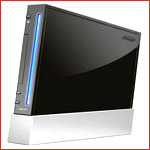Video Game Consoles - Nintendo
Revolution
NINTENDO REVOLUTION
 Nintendo
Revolution is the codename for Nintendo's fifth video
game console and the successor to the Nintendo GameCube.
The system was unveiled at Nintendo's 2005 E³ press
conference, and while a release date has not been confirmed,
it is expected to be released sometime during 2006. Nintendo
Revolution is the codename for Nintendo's fifth video
game console and the successor to the Nintendo GameCube.
The system was unveiled at Nintendo's 2005 E³ press
conference, and while a release date has not been confirmed,
it is expected to be released sometime during 2006.
Nintendo has been coy with the release of information
regarding the Revolution, leading the media to suggest
that Nintendo is not prepared to compete with Microsoft
and Sony. Top executives at the company deny this and
insist that they are simply protecting their ideas, designs,
and intellectual property from imitation by competitors
before the system can be released. Prior innovations (such
as the inclusion of an analog stick as standard, wireless
controller technology, and force feedback devices for
controllers) have been widely disseminated following their
mainstream arrival on Nintendo's machines.
Nintendo has announced that IBM has been working with
the development of the CPU, codenamed "Broadway".
IBM was previously involved with the development of the
processor in Nintendo's current system, GameCube. Nintendo
has also announced that Canadian graphics card maker ATI
Technologies is involved with the GPU, which is codenamed
"Hollywood". Before the GameCube's release,
ATI had bought ArtX, the company responsible for the GameCube's
GPU and whose members were made of former Silicon Graphics
employees involved with the Nintendo 64. Nintendo president
Satoru Iwata also announced that the Revolution will be
backward compatible with GameCube games and have built-in
Wi-Fi for online playing, provided by Broadcom Corporation
[1]. Nintendo has announced they will provide an optional
PC-compatible wireless router for use by consumers that
do not already have access to a wireless connection. The
accessory is reportedly compatible with both the Nintendo
DS and Revolution. While no ethernet port is planned,
Nintendo has suggested ethernet may be possible for the
system with USB via an adaptor. MoSys, whose 1T-SRAM memory
technology was used in the GameCube, will again provide
the same technology for Revolution.
Nintendo has gone on record as stating that the Revolution
will use standard DVD as its medium, and the Nihon Keizai
Shimbun newspaper has added onto this specification by
stating that the system will employ 12 cm optical discs.
Nintendo later removed these claims from official press
releases and hinted that they might utilize the new Blu-Ray
or HD DVD technologies which Sony and Microsoft (through
a planned upgrade) will employ in their next generation
consoles. Nintendo would not be specific when asked about
which format would be used, but confirmed around eight
gigabytes of data would be the approximate capacity of
a Revolution DVD. The Revolution will accept both Revolution
and GameCube disks, a first for slot loading drives. It
will also have the ability to play DVD movies with an
"internal add-on". While all Nintendo consoles
to date have expansion serial ports, none have been announced
for Revolution. Other information states that Revolution
will be able to hook up to a computer monitor as well
as a TV. However, Nintendo has confirmed that at this
point in time, they are not supporting HDTV output for
the Revolution, however, 480p will be standard. [2] This
may mean that the system will be unable to output HDTV
at all, or it may mean that HDTV support will be at the
developer's discretion.
Nintendo also has said the console will be "sleek",
approximately the thickness of three DVD cases, and stand
both horizontally and vertically, considerably thinner
than the Xbox 360 and Playstation 3. This new industrial
design will also address remarks regarding the Gamecube
and its "toyish" look which some have complained
does not fit in amongst most home entertainment components.
Final version is to be smaller than the presented E³
prototype.
| Nintendo Revolution
Known Specifications |
| CPU |
IBM PowerPC CPU "Broadway"
ATI GPU "Hollywood" |
| Memory |
1T-SRAM by MoSys
512 MB built-in flash memory |
| Ports & Peripherals |
Two USB 2.0 ports.
No proprietary serial ports announced.
Wireless controllers.
A single proprietary output for video and audio.
A dongle enabling DVD playback.
4 Gamecube controller ports and 2 Gamecube memory
card ports (for compatibility).
Optional USB PC-compatible 802.11b wireless router. |
| Media |
The first slot loading optical disc
drive capable of handling both 12 cm and 8 cm proprietary
optical discs (again, for GameCube compatibility).
2 front loading SD memory card slots. |
| Networking |
Wi-Fi by the Broadcom Corporation: Built-in 802.11b
& 802.11g support.
No Ethernet port. |
|
|
Max Shooter XBOX & PS2 Keyboard
& Mouse Adapter Review
by Jeromy
The third and latest XBOX/PS2 keyboard & mouse adapter
to hit the market is the Max Shooter. Before this adapter
was released there was a good chance that the guy destroying
you in Halo 2 was using a regular XBOX controller and
not one of the previously released keyboard & mouse
adapters. Enter Max Shooter stage right. Now you should
be afraid, very afraid, as the Max Shooter basically turns
the console FPS into a PC FPS with all the accuracy that
that entails. After spending a good few days playing Halo
2, Socom II, and Unreal Championship 2 there is little
doubt that FPS games were mostly made to be played with
a mouse and keyboard.
[ More ]
|
|